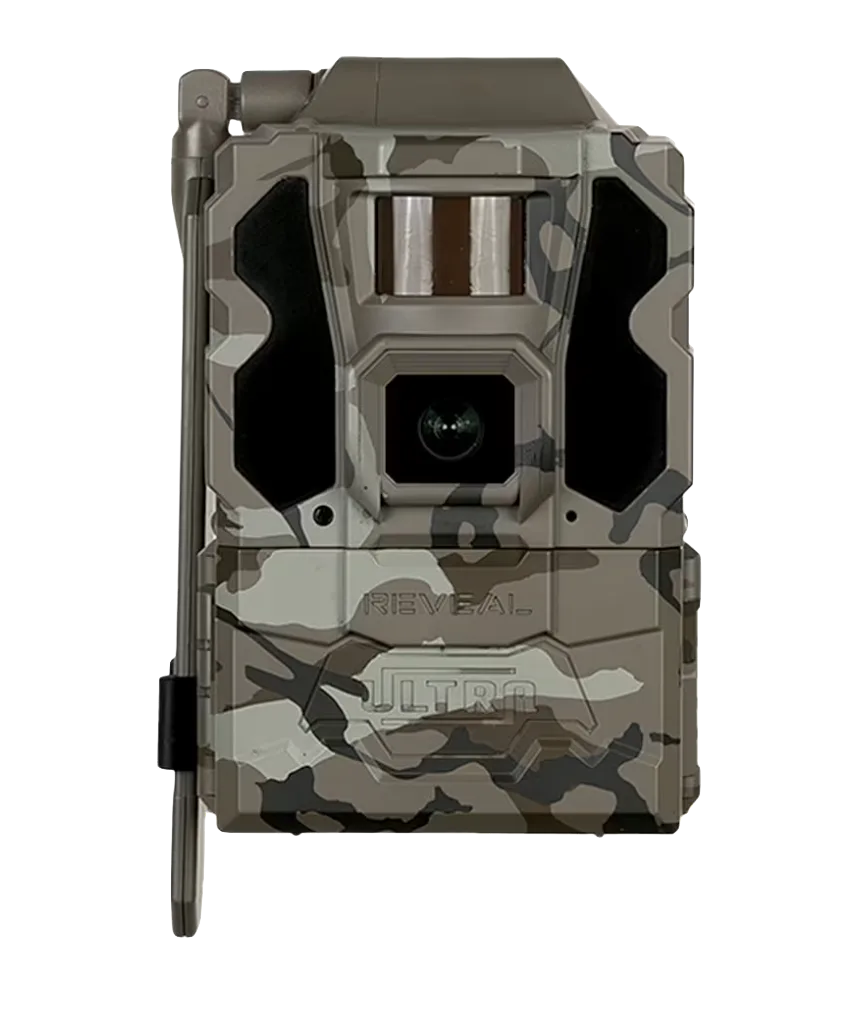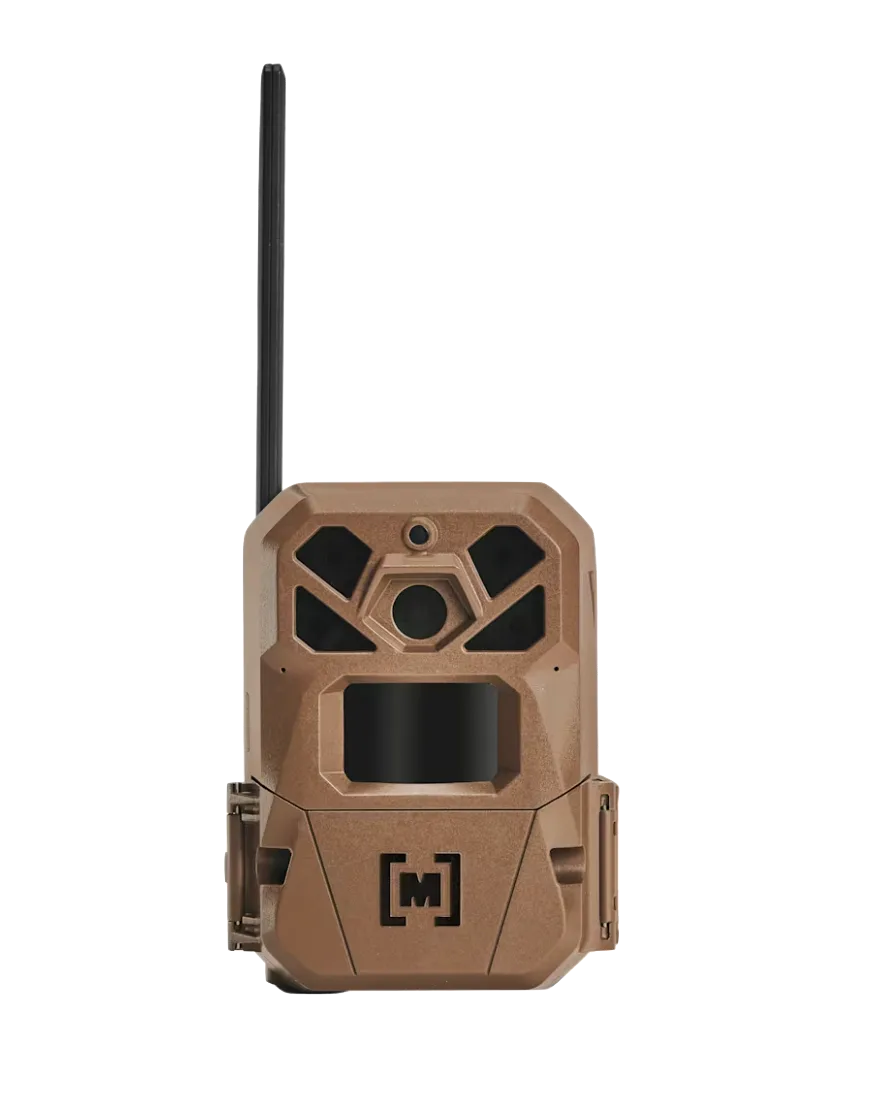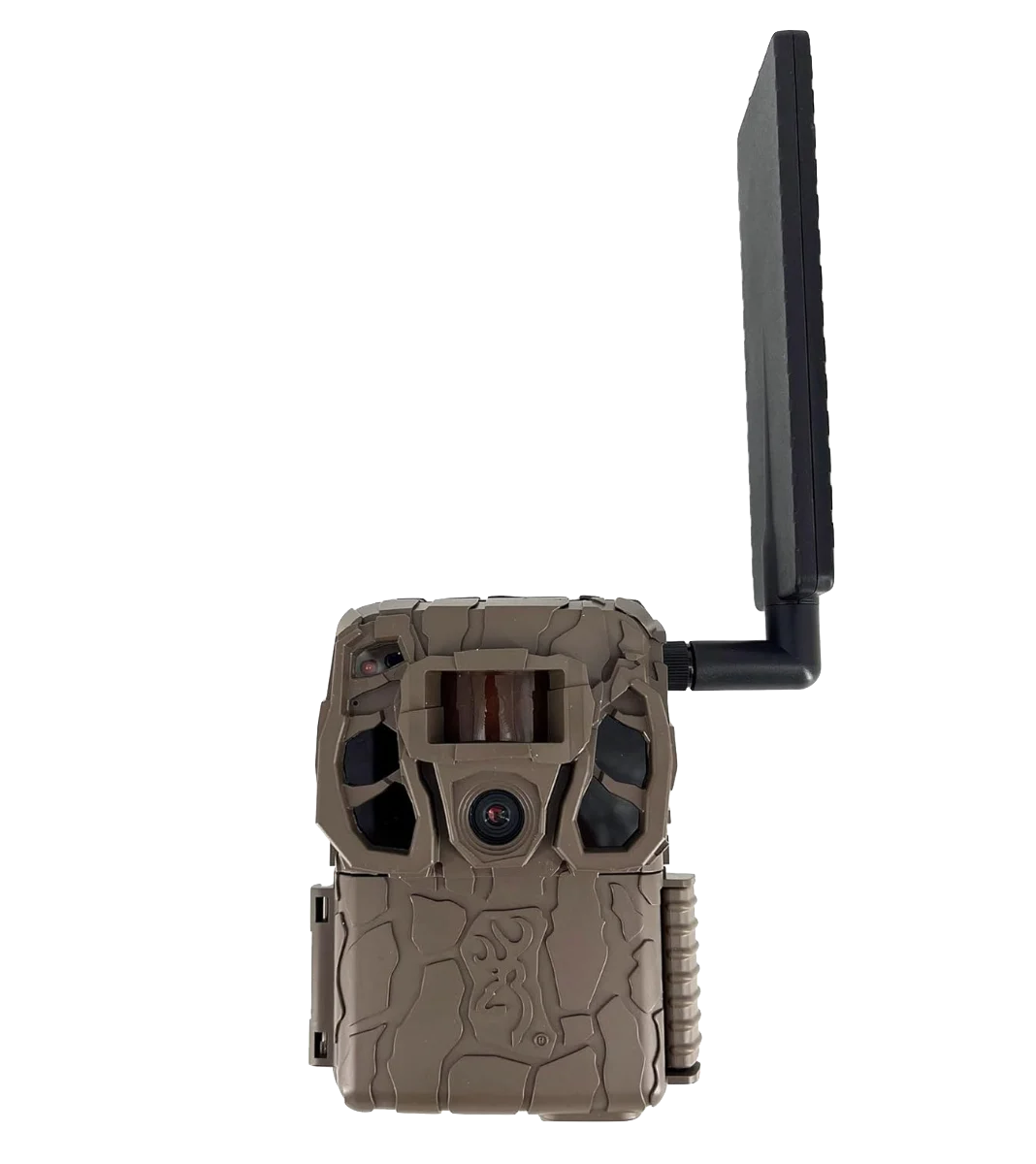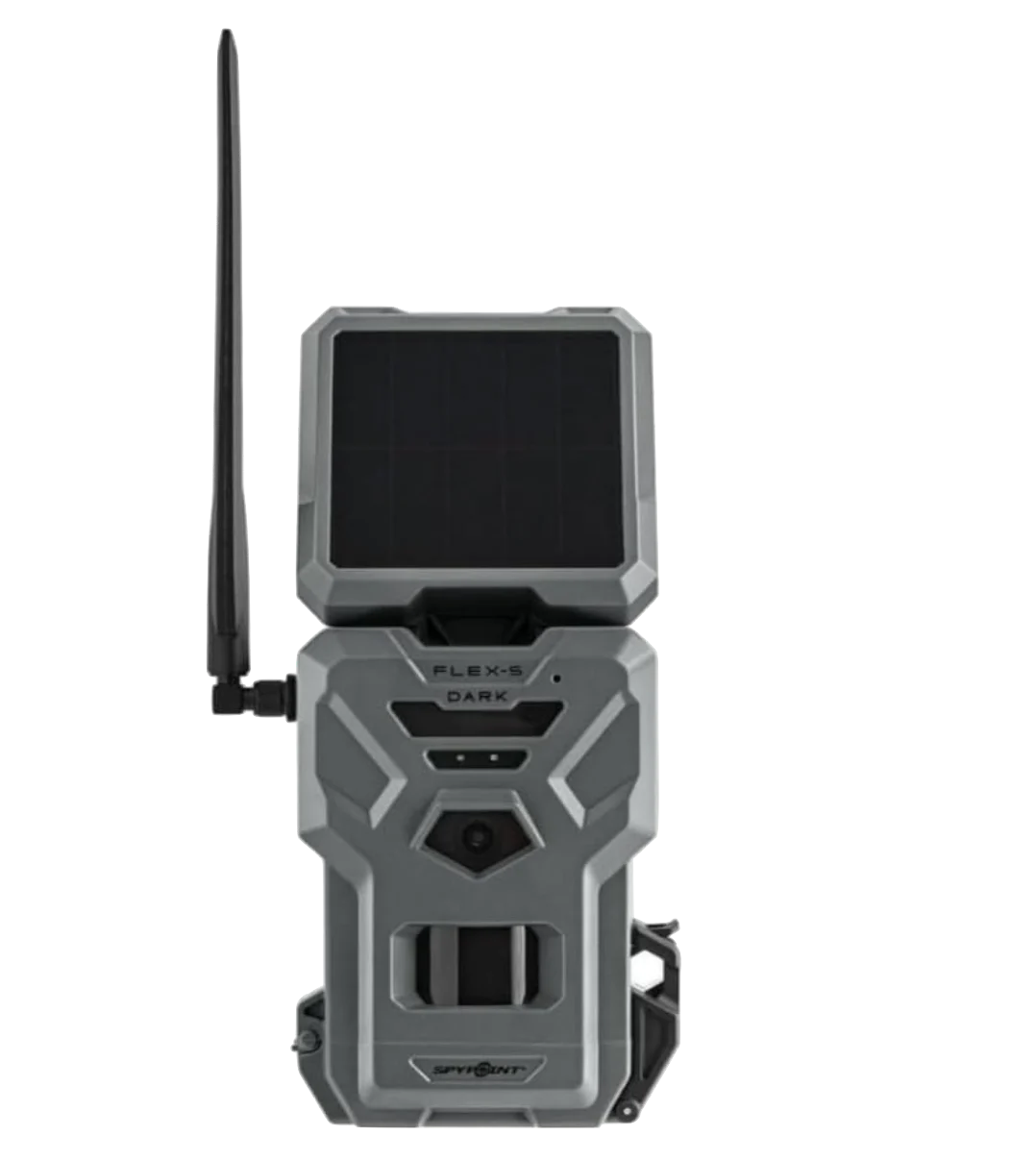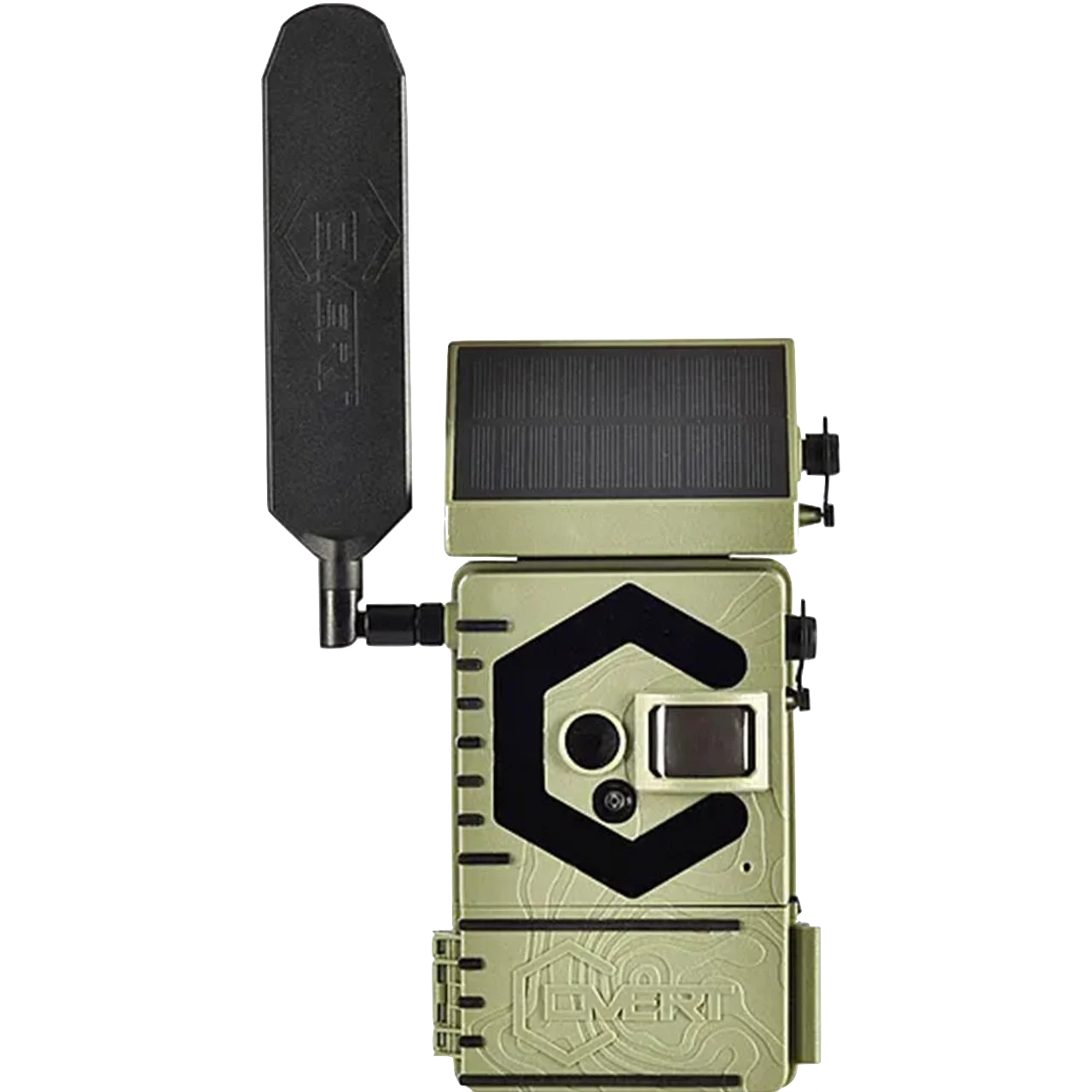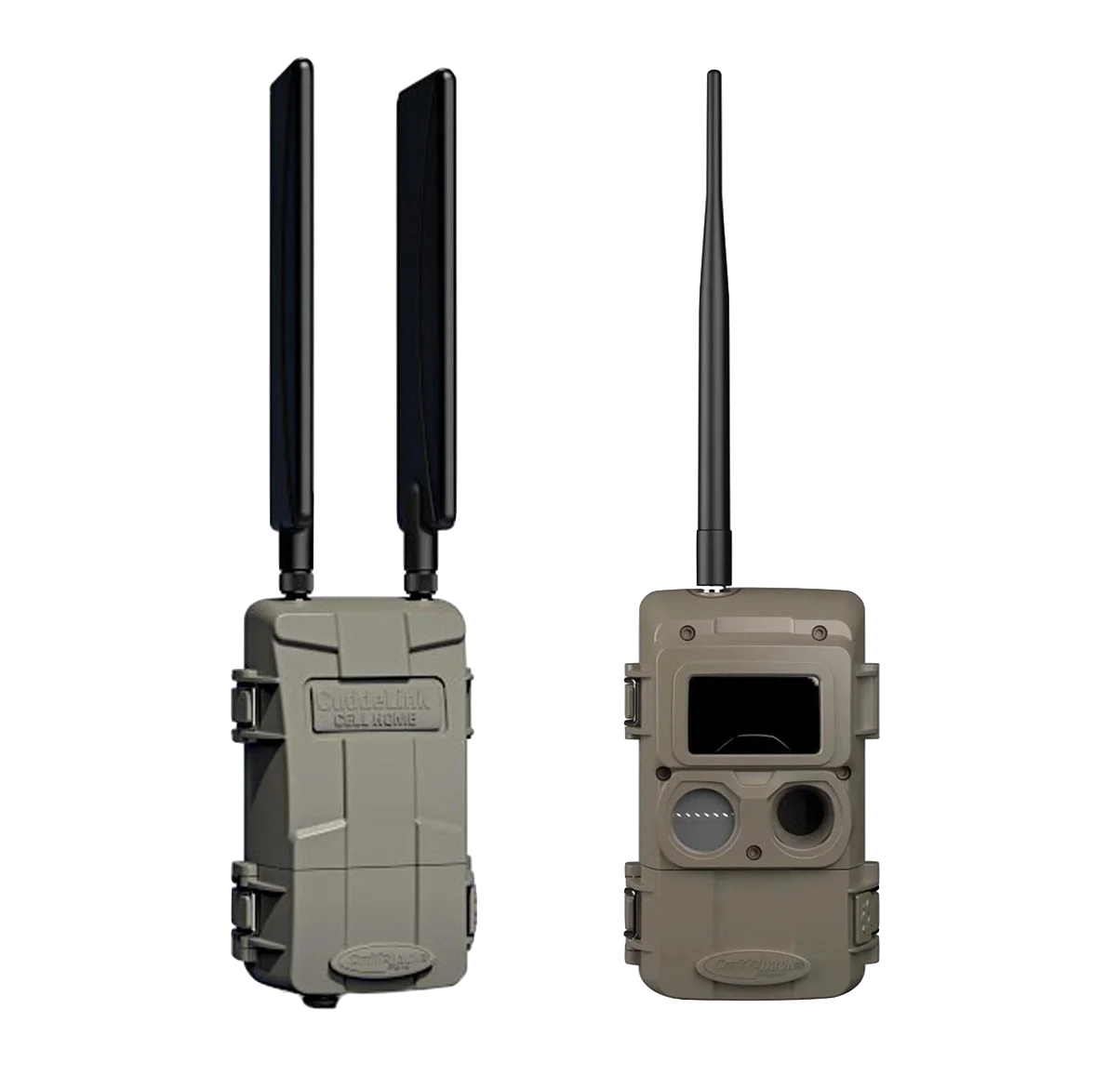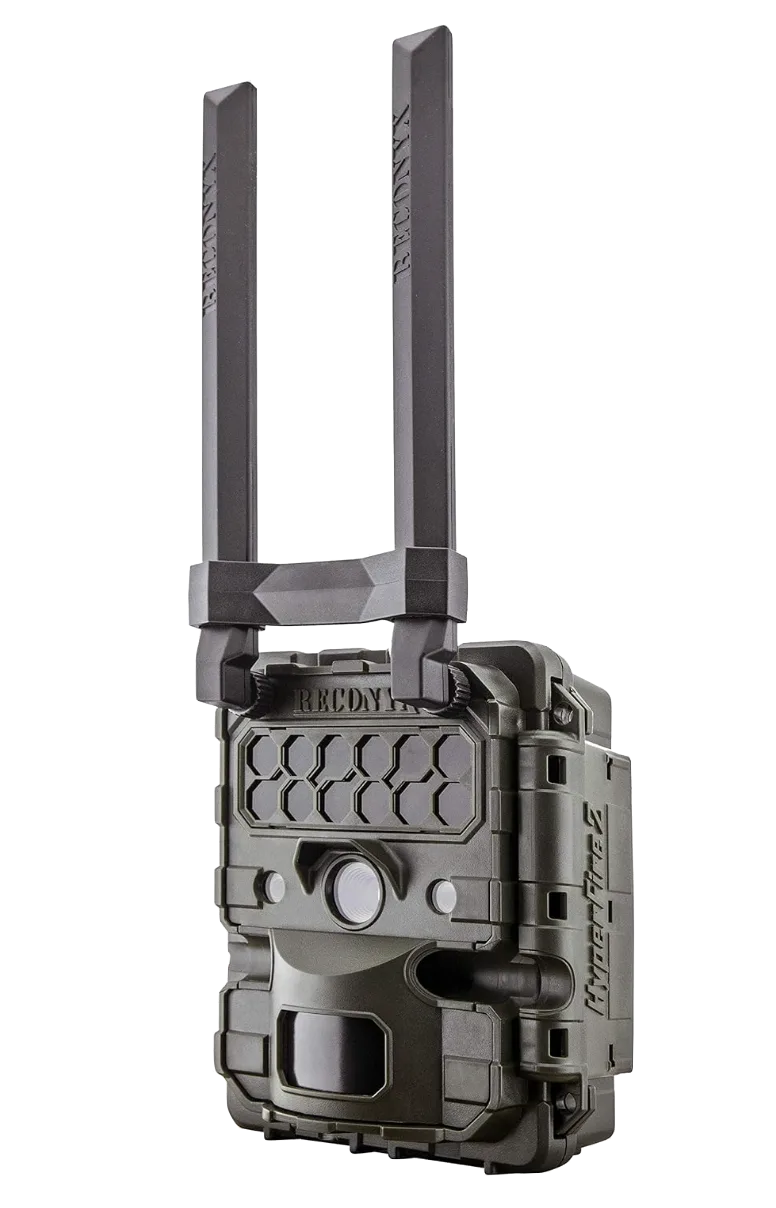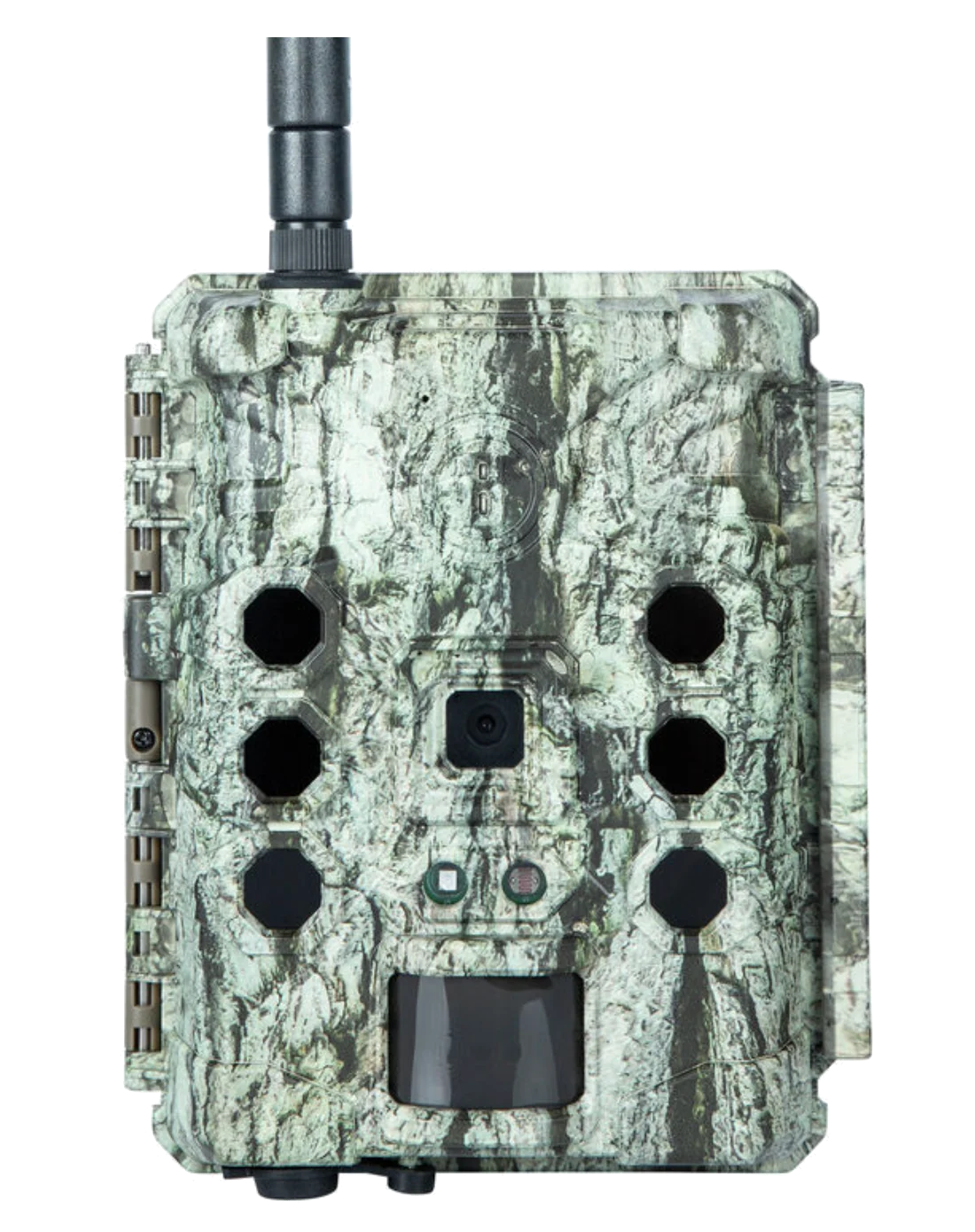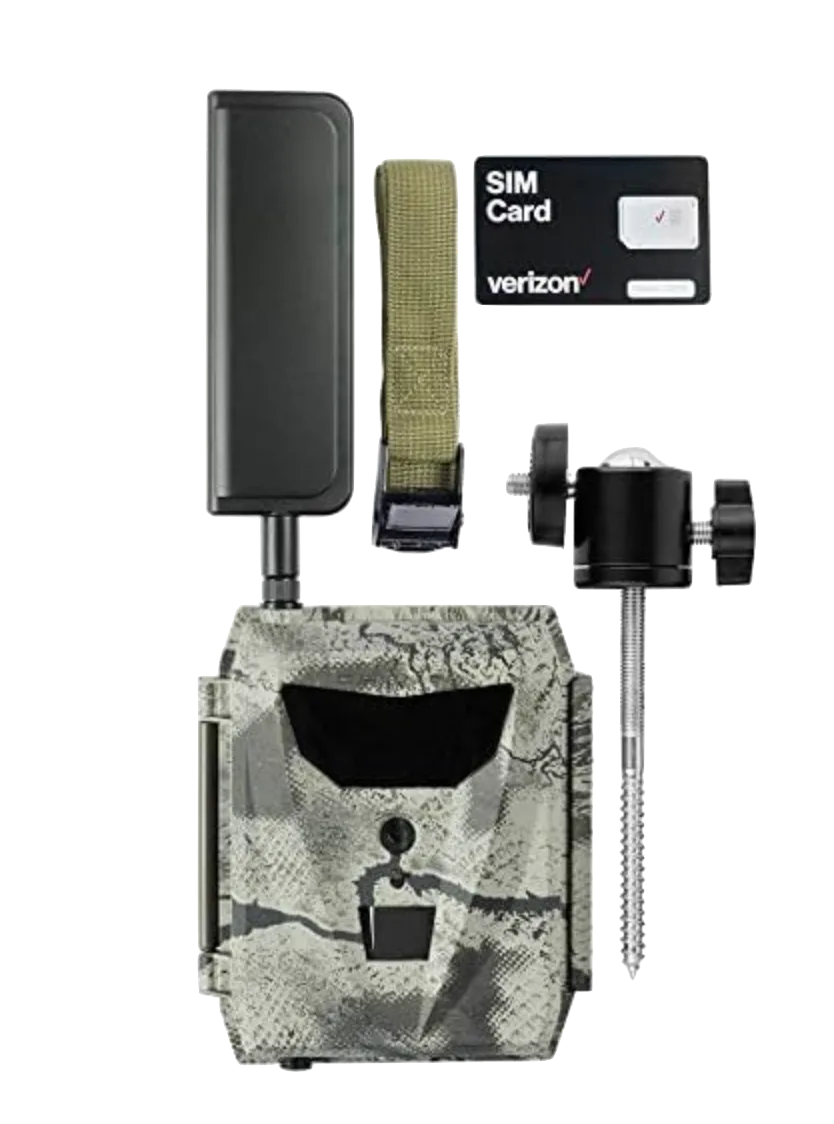the We may earn revenue from the products available on this page and participate in affiliate programs. Learn more
I've been running trail cameras since film-based models were all the rage the early 1990s. I remember walking laps around the local Walmart, waiting for the one-hour photo lab to process my prints. Most of the time, it was 24 images of a branch that the wind blew back and forth. Occasionally, I'd get a deer—sometimes even a good buck.
Trail cams have come a long way since. Film is history, of course, and while conventional digital cams won't be going away any time soon, cellular trail cameras dominate the scene today and have proven to be game-changers in the field. If you want to learn all you can about the critters you hunt without setting foot in the woods other than to change batteries or move a camera or two, cellular trail cameras are the way to go. And with so much competition among manufacturers to offer hunters the most for the least, cell-cam costs have not gone through the roof like everything else.
All of the newest models for 2025 sell for under $220, including some well under—and all are packed with cutting-edge technology. To help you figure out which models are right for you, I spent weeks running and testing the latest cams on a prime 700-acre whitetail property in Colorado. Nearly every cellular trail camera I tested met and exceeded my expectations. So on one hand, you can't go wrong. Still, you want to get model that's exactly right for your needs, and this test will likely help you do that. So, let's jump in.
The Best Cellular Trail Cameras of 2025
Best Overall: Tactacam Reveal Ultra
Best Value: Moultrie Mobile Edge 3
Best Photo Quality: Browning Defender Vision Pro LiveStream
Best Detection: Stealth Cam Revolver 2.0 360°
Best Stealth: SpyPoint Flex-S Dark
Best Trigger: Covert Interceptor Solar
The Rest of the Best
Related: 60 Craziest Trail Camera Photos We've Ever Seen
Best Overall: Tactacam Reveal Ultra
Specs
Trigger Speed: Under .4 seconds
Detection Range: Low Glo (96 feet); No Glow (80 feet)
Power: 12 AA (other accessory power options available)
Price: $199.99
Pros
Exceptional Low-Glo and No-Glow range
Easy setup
Purposeful new features
Live Mode
Cons
Sub-par dawn and dusk clarity
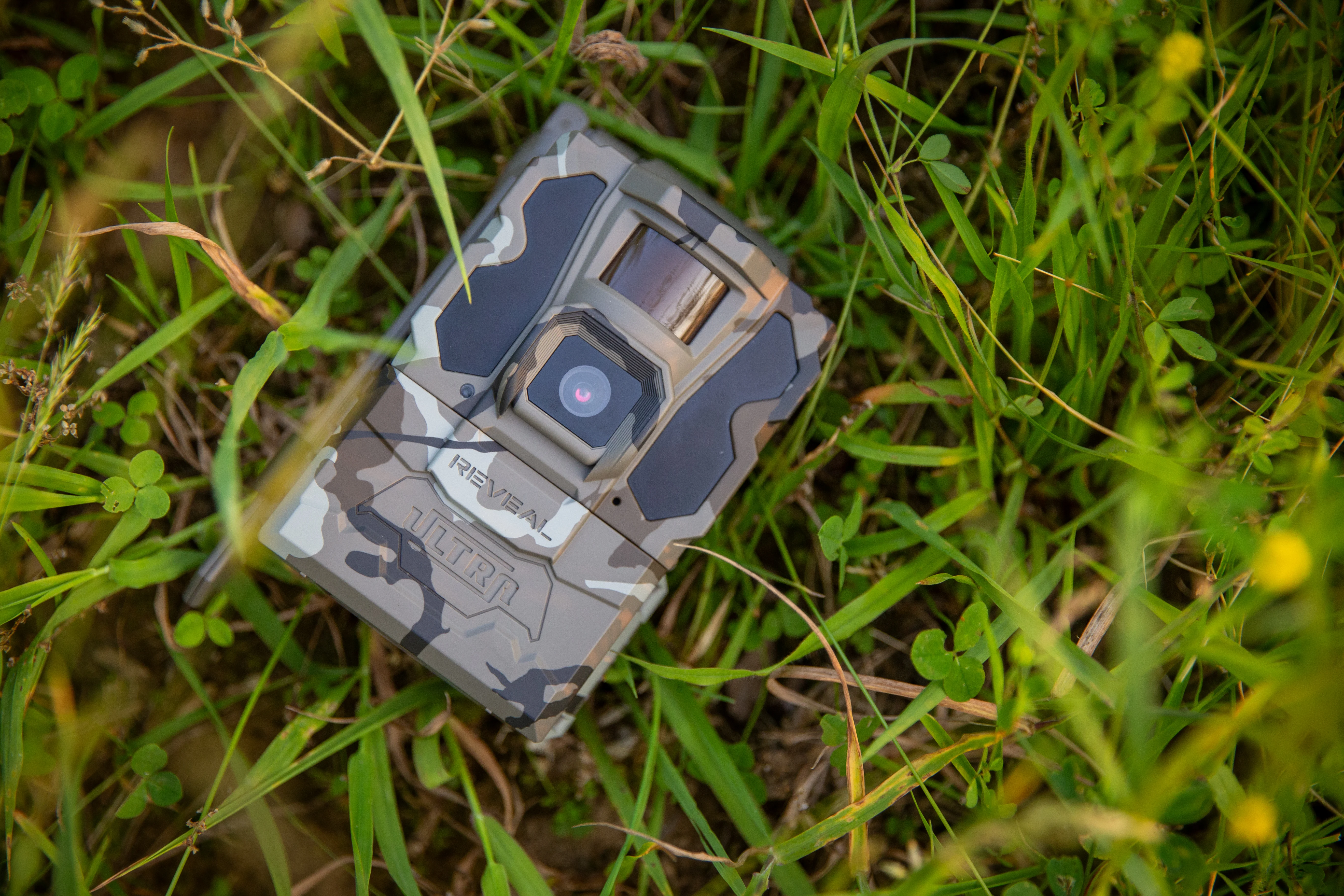
While the price of cellular cameras has come down, it's not uncommon to pay more than $200 for a model loaded with bells and whistles. What impressed me about the Ultra from the get-go was that I got all the bells and whistles I needed in a cellular camera that hit a price point under $200.
The Reveal app is easy to use, and it walks you step-by-step through the setup process. I had my Ultra up and running and transmitting photos to my phone in less than two minutes. Still, lots of cellular trail cameras in this year's test ensure easy setup and have highly functional apps. What sets the Ultra apart is the camera's low-glow and no-glow flash settings, Live video streaming, Active GPS, and the number of blank images the camera takes.
I tested the camera's low-glow setting on a river crossing. The crossing is tight, and the camera triggers the second a deer's head pops over the edge of the riverbank. The no-glow flash didn't spook deer and still provided exceptional range.
I tested the camera's low-glow flash along the edge of a standing cornfield. The trail going in and out of the corn was over 100 feet away, and the low-glow setting captured excellent photos and videos. The trigger speed is fast, and the deer are centered in the images.
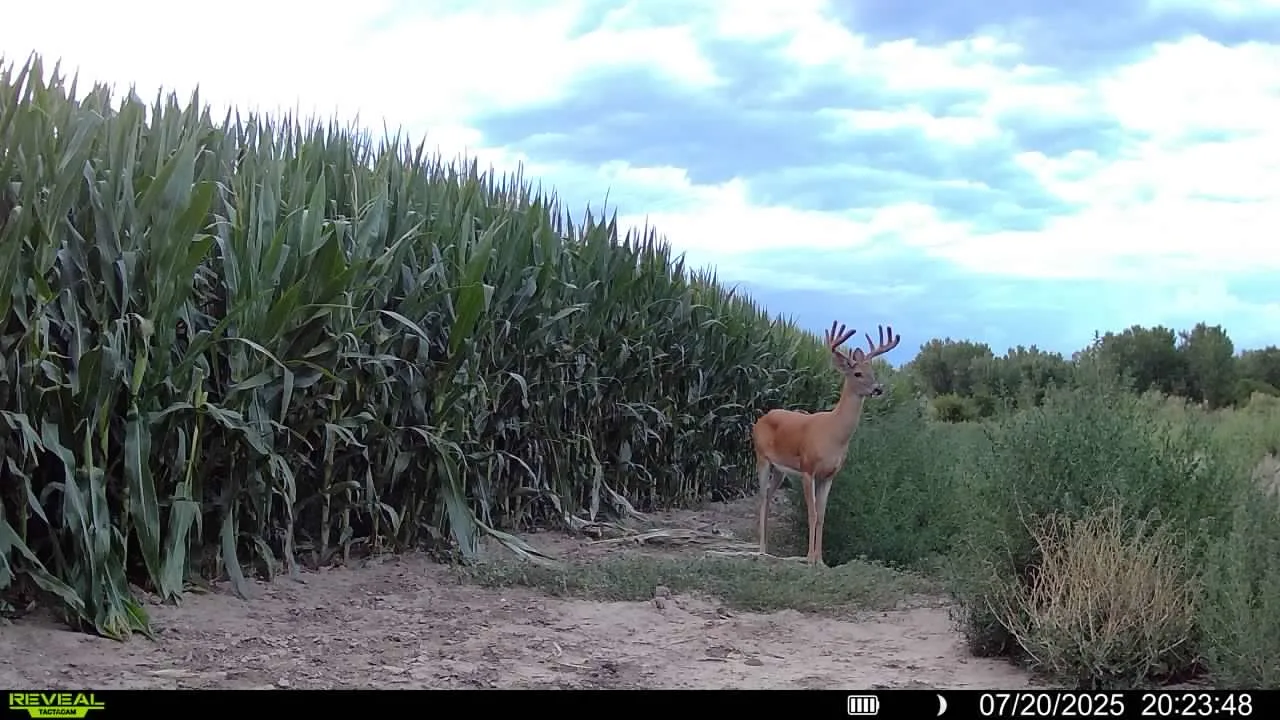
For testing purposes, I had my son Hunter steal the Ultra. Active GPS sent me a notification that the camera had moved more than half a mile from where I'd placed it. Even after Hunter powered the camera off, I continued to get coordinates, which is an impressive feature.
Using a dozen standard alkaline batteries, camera life was excellent, and when I requested a high-resolution photo or video, the quality of both was impressive. Live video streaming lets you monitor the area in front of your camera in real time, which is beneficial for scouting and hunting purposes. I also appreciate the camera's HuntSynch feature. This feature lets you turn off the camera's cellular function with the push of a button, and you get a date and timestamp showing when the switch was made. This is an excellent feature for people in states that limit cellular trail camera use.
Overall, the Ultra gives the end user everything they need and nothing that they don't. All the features work as advertised, every feature is purposeful, and the cellular camera is foolproof.
Best Value: Moultrie Mobile Edge 3
Specs
Trigger Speed: .5 seconds
Detection Range: 100 feet
Power: 16 AA batteries, but will run on eight (Other accessory power options available)
Price: $99.99
Pros
Elementary setup & functional app
Live Aim even if your phone has no signal
Moultrie Connect works with Moultrie Feeders
Cons
Nighttime blur
Many false triggers in the wind and during periods of intense heat
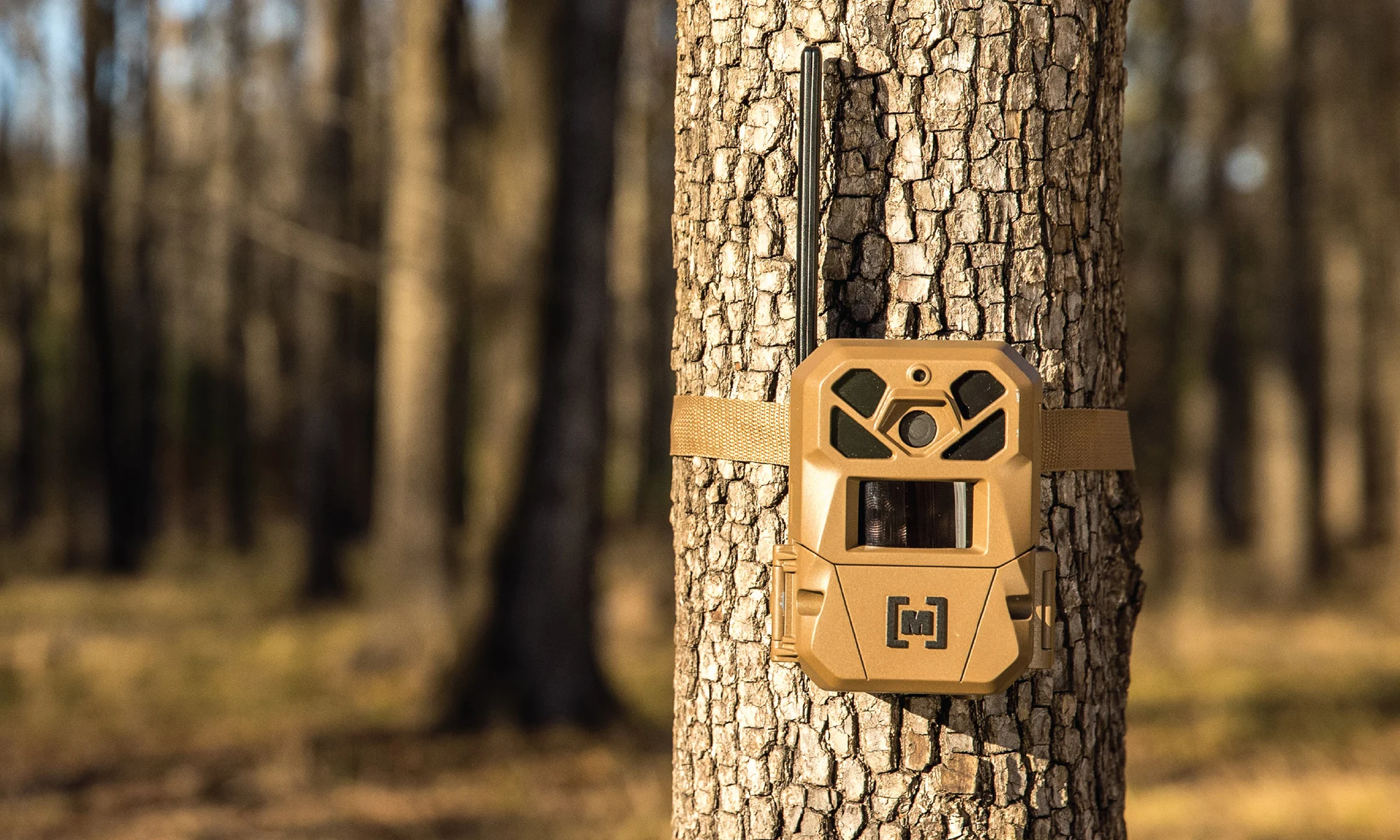
If we had an award for Easiest Setup, the Mobil Edge 3 would get it. It's a piece of cake to get up and running. Download the Moultrie App, scan the camera's code, and let the app guide you through the process. Setup time takes minutes.
Regarding the camera, I appreciate the robust housing and the built-slot that holds the folded-down antenna in place, where it can get snagged and break. The tall and wide antenna also is quick to get a signal. I like the push-up "On" button, and the four colored lights that indicate the quality of the connection. Battery life was excellent with AA batteries on the Edge 3. Still, Moultrie also offers solar and battery packs that can further extend battery life. I tested the Edge Series Power Mag Plus battery pack and the 10W Solar Power Pack out of curiosity, and both significantly boosted battery life.
New GPS location means you'll never forget where you put this cell camera, even if you don't pin it to your favorite digital scouting app. Live-Aim lets you look at your smartphone and see exactly where the camera is pointing and what it will capture. This saves a lot time, especially if you prefer to hang cameras high and angle them down or set them low and angle them up. Moultrie's AI is back, which allows you customize video and picture setting. For example, I set mine to automatically send videos of bucks but only photo of does. Other AI features will compile analytics on which areas are receiving the most buck traffic.
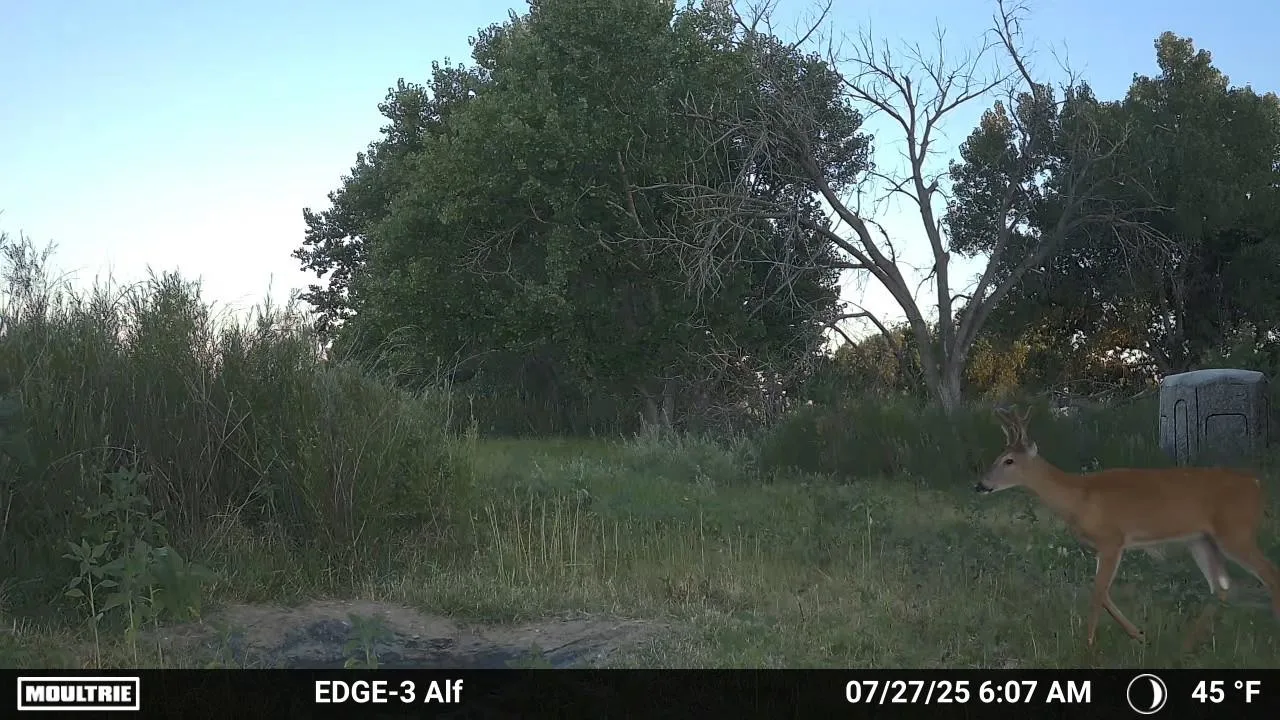
The Edge 3's advertised 100-foot detection proved out during the day, but nighttime photos taken between 90 and 100 feet were blurry, and the AI struggled to detect the correct species in the image. (It one case, it told me that a whitetail doe was a wild pig.) The camera does not require an SD card, which reduces expense and saves formatting headaches. The photo and video quality are excellent up to 80 feet, day or night but fall off a bit beyond. The Edge 3 (and Edge 3 Pro) pair with Moultrie feeders for remote, cellular feed management. This is a new feature, but I was unable to test it because feeding deer is illegal where I live.
We do have an award for Best Value, and the Edge 3 gets it by a mile. This is a user-friendly camera with a fast trigger, solid detection range, and useful features for less than half of some of the other cameras here.
Related: 30 Trail Camera Tips for Getting More and Better Pictures
Best Photo Quality: Browning Defender Vision Pro LiveStream
Specs
Trigger Speed: .5 seconds
Detection Range: 110 feet
Power: 8 AA batteries (Other accessory power options available)
Price: $219.99
Pros
GPS Theft Protection
Live Streaming
Real Time Radar & Weather
Cons
AI recognition is hit or miss

I haven't had the best of luck with Browning's Defender Series of cellular cameras in the past years. My most significant issues were false triggers and battery life. The good news: Browning solved both problems for 2025 with theDefender Vision Pro LiveStream—and created one of the best cams in this year's test.
The Vison Pro LiveStream was a breeze to set up. The Strike Force app guides you through each step, and in under four minutes, I had the camera set up on a river crossing. The coolest new feature on this cam is its real-time 1080p HD video capability. At any moment, you can start the LiveStream from the app on your phone and immediately watch the action in front of your camera for up to five minutes. When you select a payment plan, you can choose the number of LiveStream minutes you want to purchase.
During testing, this camera shot me pic a young 10-point buck, so I switched to LiveStream for fun. Forty-two seconds later, a bigger 10-point came up the crossing. I had the camera set on a 45-second delay and would have missed that bigger buck without LiveStream.
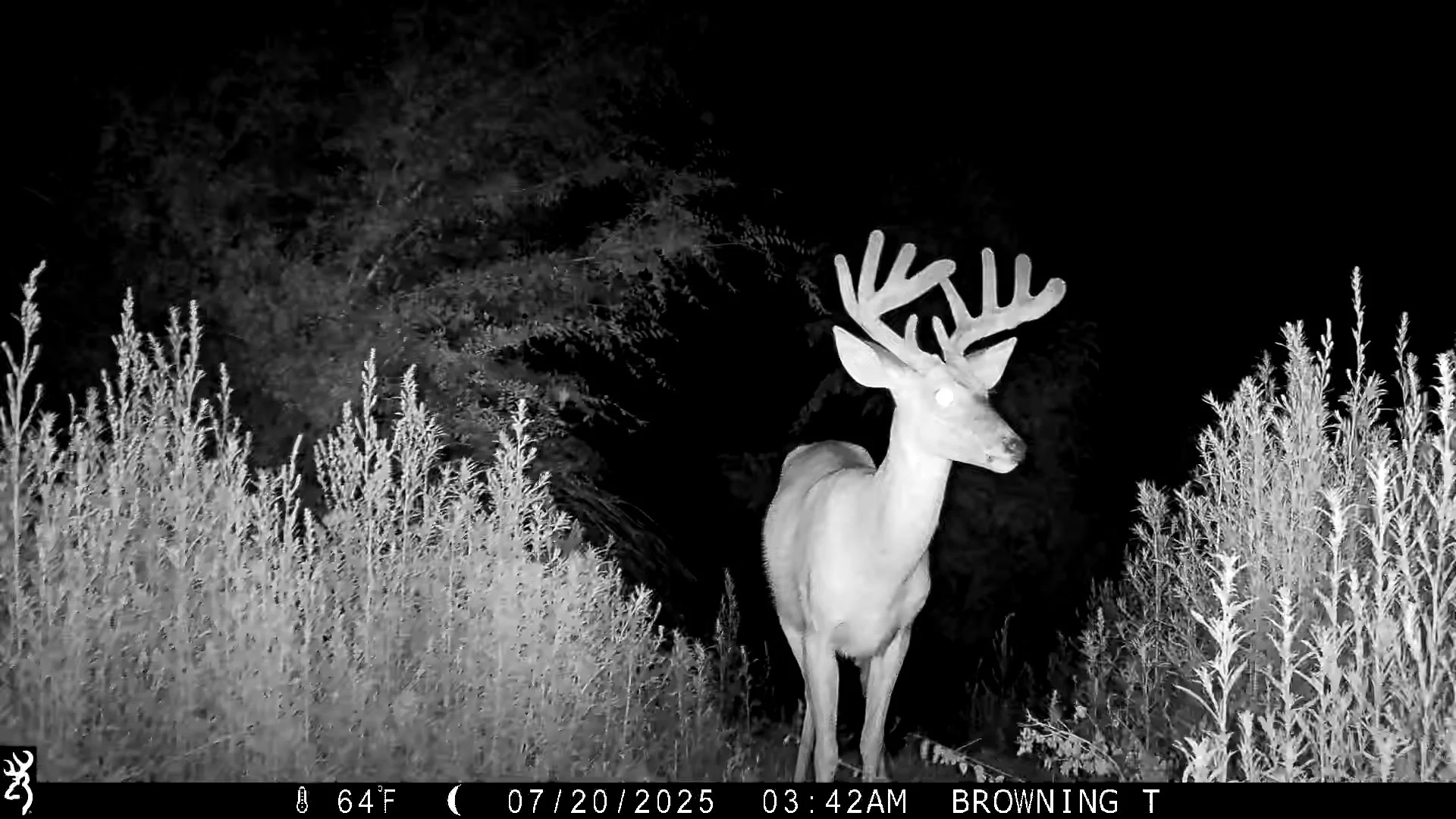
With the Defender Vision Pro LiveStream, you don't have to worry about requesting and waiting for HD photos. All photos are captured in HD, and the 46MP photos, even at night, are top quality. This camera, set at four locations for 20 days, captured 197 photos of deer. Only one was blurry, and it was a fawn that a coyote was chasing. As with many cameras in the test, this one has a new GPS tagging feature that allows you to determine the camera's location, and Browning has added GPS Theft Detection. This valuable feature provides enhanced security.
One small issue I had with the camera was with its AI recognition technology, which mistook two whitetail does for hogs. But I don't care. If you're a hunter, you know the difference between deer and hogs.
The camera's infrared night vision did not seem to spook deer, which is a big plus, but my test camera didn't quite live up to its advertised nighttime detection range of 110 feet on deer-sized animals. Still, it was strong compared to most units, extending up to 90 feet. Overall, the Defender Vision Pro LiveStream checks all the boxes, will make an excellent cell scouter on any property, and gets out award for best picture quality.
Best Detection: Stealth Cam Revolver 2.0 360°
Specs
Trigger Speed: .4 seconds
Detection Range: 100 feet
Power: 16 AA batteries
Price: $149.99
Pros
Captures six activity zones
Live Steam
2K vide and 4K HD photos
Cons
Lots of thumbnails to sort through
Weak antenna
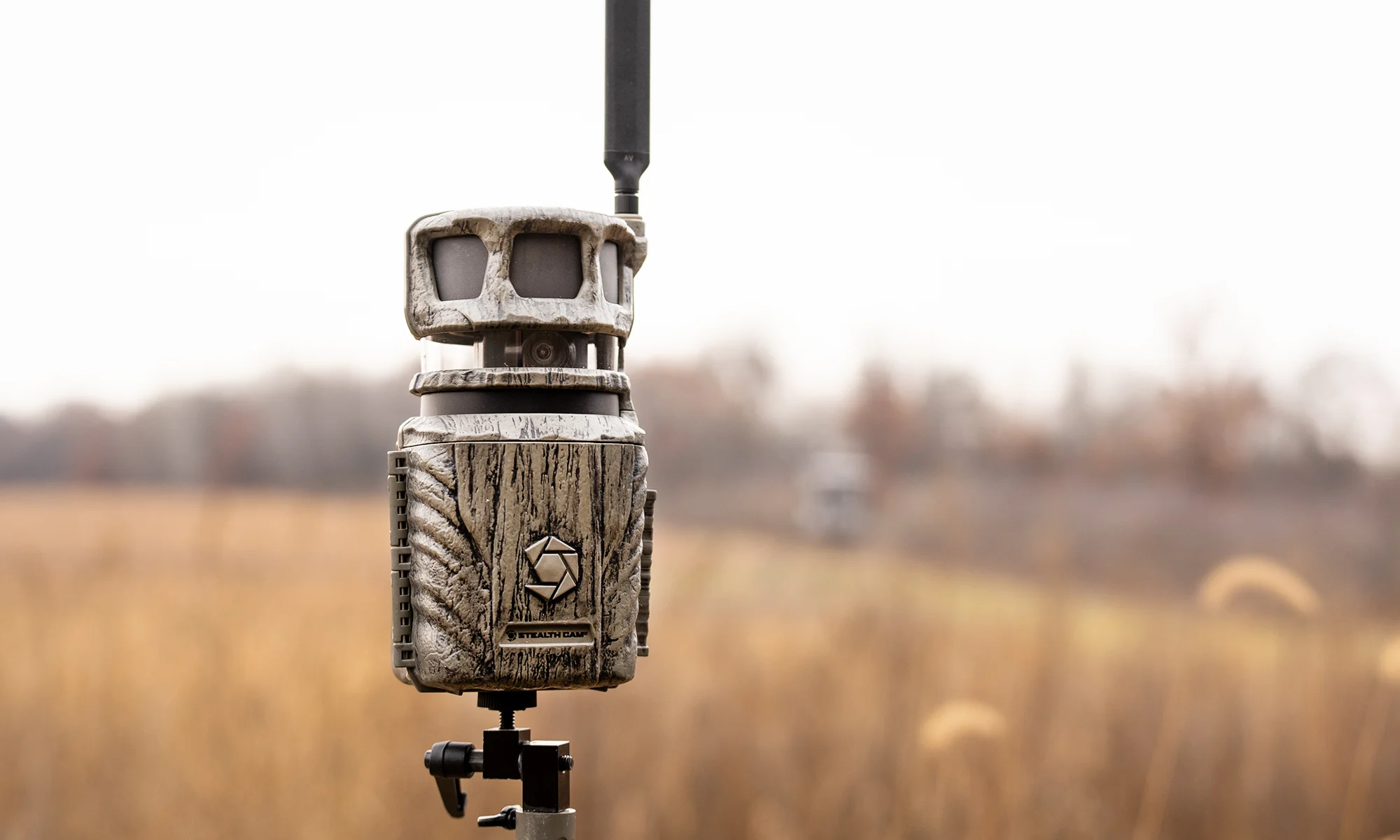
Though taller and more challenging to conceal, Stealth Cam's Revolver Pro 2.0 is one of my favorite cellular trail cameras of 2025. The biggest reason is the camera's ability to capture images in every direction, using six different zones. Individual zones can be turned on and off, but when all are on and the camera triggers, you get six thumbnails. This is super handy when using the camera on a food plot or on a trail intersection where it's easy to miss deer. You will have to scroll through many images, but when you see a deer, select the image, and then you can scroll through pictures of that zone. It does take some getting used to, but I love it, and it serves its purpose.
The Command Pro app is easy to use, and like most cameras in this test, all settings are controlled via your smartphone. The 2.0 360° features Live Stream On Demand, which lets the camera capture up to five minutes of live video footage of what's going on at the camera. It's a great feature; you pay for it, but the video is crisp and clear. HD images can be requested and will be sent to your phone the next time the camera triggers. Concerning image quality, these 4K images are bright, clear, and provide a lot of detail.
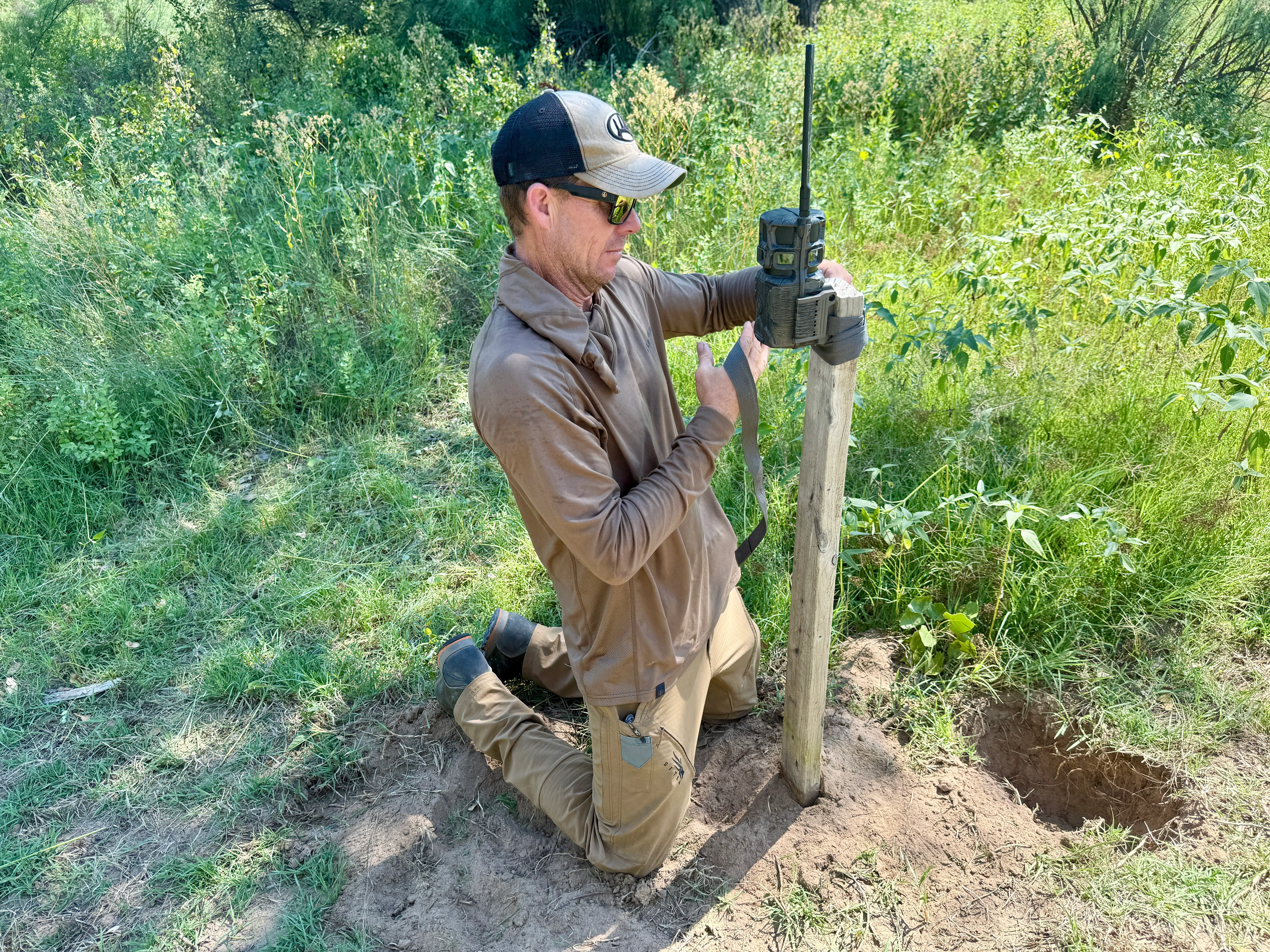
As with all but two cameras in this year's cellular trail camera test, the Revolver Pro 2.0 360° doesn't use an SD card; instead it has 32GB of integrated internal memory and images are easily cleared. The one downside of having so much coverage is that you'll have lots of thumbnails to go through. Also, this camera's attenna was a bit flimsy compared to others. That said, the camera's trigger speed is more than fast enough. Images, even at night and during dawn and dusk, were clear. All in all, the 2.0 360° is an excellent cell camera that provides easy setup, excellent detection, and is a solid value, to boot.
Best Stealth: SpyPoint Flex-S Dark
Specs
Trigger Speed: .3 seconds
Detection Range: 100 feet
Power: Solar
Price: $149.99
Pros
On-board solar power lasts for weeks
Long detection range with no flash
1080P video with sound
Cons
Video requests often took more than one camera trigger
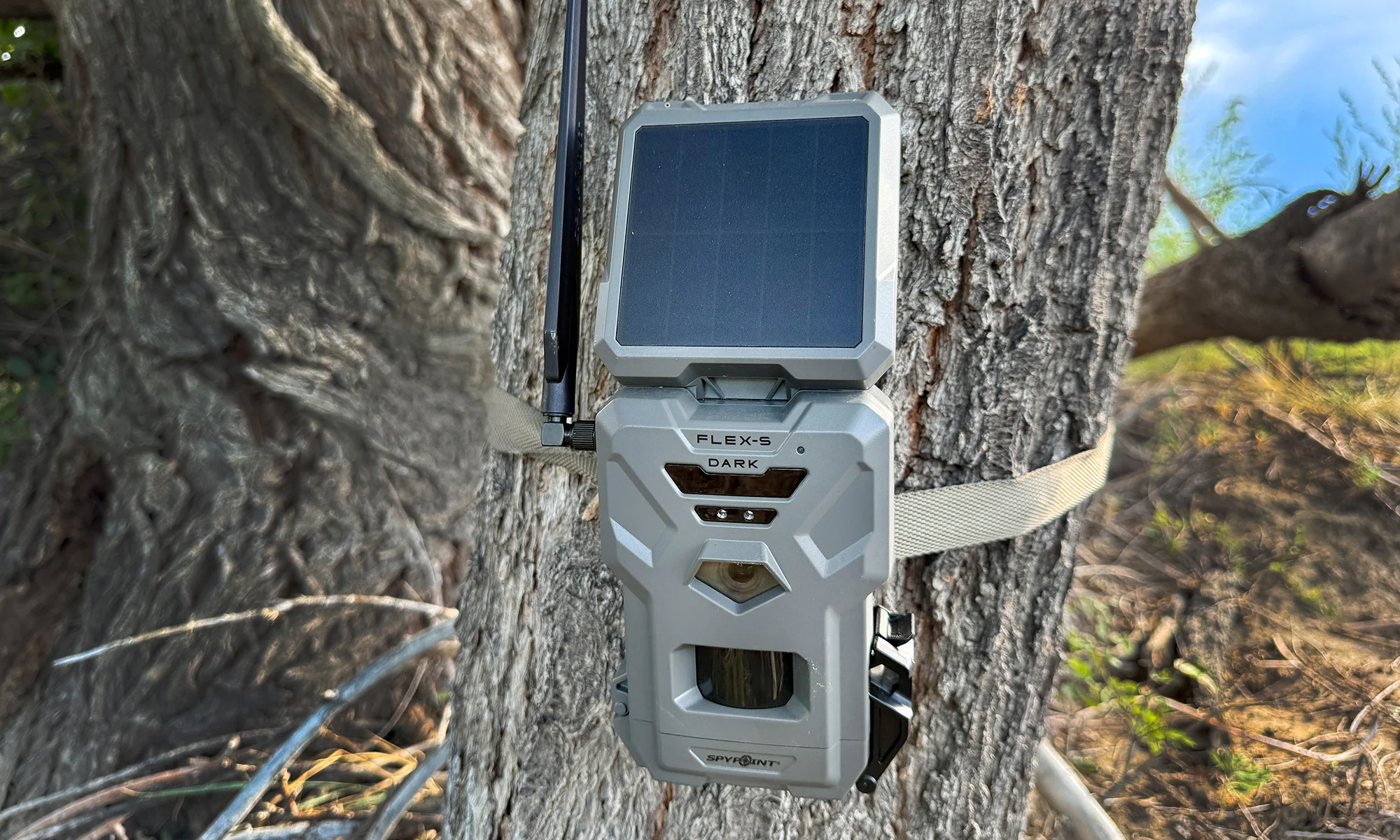
I love the built-in solar panel on the Flex-S Dark, and the fact that there are no additional cords or hookups. You just charge the camera for 12 hours before deployment, and you're good to go. My test camera has been running for 20 days, has taken 204 photos of deer, 13 photos of coyotes, one picture of a bobcat, and 22 false triggers. The solar battery life has never dipped below 68 percent.
SpyPoint advertises the Flex-S Dark's detection range out to 100 feet, but in my tests, it captured daylight and nighttime images at a river-crossing trail 112 feet away, no problem. Even when it's pitch black outside, the camera doesn't make a visible flash, which means game spooking isn't an issue, making it a great choice for rut funnels, trail intersections, and scrapes. And with the detection range as good as it is, I would have zero concern using it on a food plot.
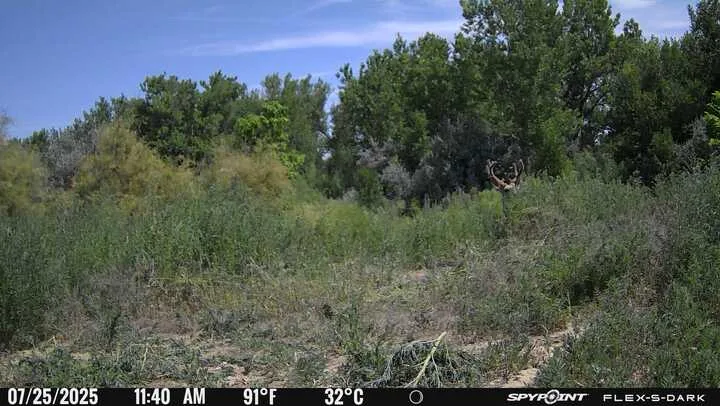
The camera's outer shell is durable, and setup via the SpyPoint app takes minutes. This cell scouter has many features, and I recommend looking at each and deciding what best fits your needs during setup. I used the multi-shot mode on a river crossing and Time-Lapse on my alfalfa plot. High-resolution images and videos are downloadable via the app, but are also stored on the SD card. If you want to save some pennies and aren't overly worried about invading your deer grounds, you can pull the card and download the photos and videos. Bottom line: The SpyPoint Flex-S Dark is a bulletproof and foolproof cellular camera that performed very well generally and is perfect in tighter places where spooking deer is a particular concern.
Related: 10 Trail Camera Tips for Elk Hunters
Best Trigger: Covert Interceptor Solar
Specs
Trigger Speed: .4 seconds
Detection Range: 90 feet
Power: Solar backed up by 8 AA batteries
Pros
Rapid-fire trigger
Real-time video
Upgraded antenna pulls poor cell service
Cons
The solar cord is big, long, and clunky
Price: $219.99
Covert has upped its game for 2025, producing a new solar cell cam scouter that's lightning fast and offers tons of great features. Like most of the cams here, the Interceptor Solar was easy to set up. Downloading the Covert app, building an account, and getting the cam operational took less than 5 minutes.
The camera's paddle-style antenna proved rigid and robust even in heavy winds. I hate antennas that turn or droop, but this one stays upright to pull optimal service. The trigger speed was the fastest in this year's test. Covert lists it at .4 seconds, but my testing showed an average trigger speed of .24 seconds. That data was obtained using two different stopwatches, as well as a chip time card that runners use.
When charged to full, the camera's on-board solar keeps the unit running, even in dense timber. Several times, the Interceptor got down to less than 30 percent battery life at night, but it would still center images in the frame, and deliver good-qualiy photos and real-time 2K video. During the day, even without direct sun exposure, battery life would rise to 80 percent. When set on a pond and alfalfa plot, the battery never dipped below 60 percent and would achieve a full charge during the day.
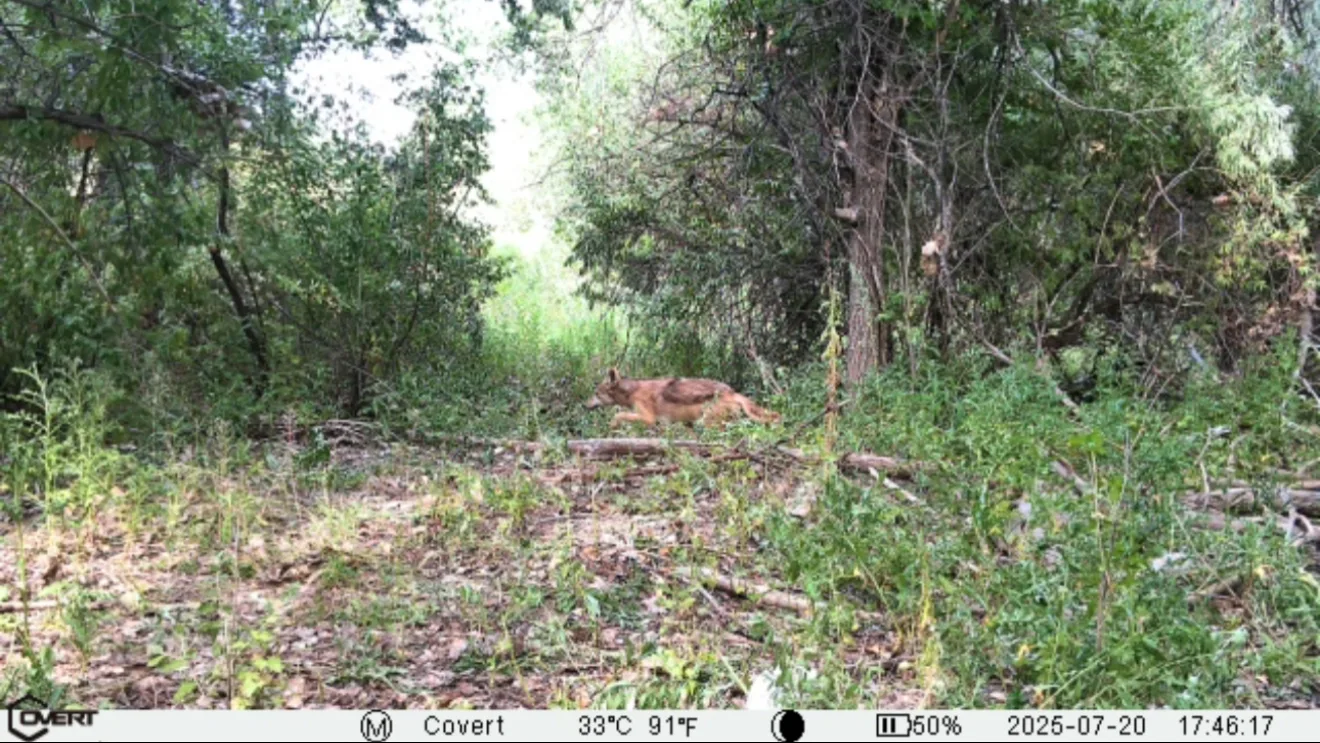
Covert lists the effective flash range at 90 feet, and my testing confirmed this. I appreciate the 2-inch screen, though very little of the actual setup work is accomplished using the camera. Everything is done in the Covert app. The Covert Interceptor Solar features on-board GPS, so you can't lose your camera, uses 8 AA batteries as backup, and comes with a 2-year warranty.
My only complaint on this otherwise excellent camera is the long and bulky cord that connects the on-board solar unit to the camera. Be sure to take some Gorilla tape or some zip-ties to roll the cord up and tuck it out of the way. But that's the end of quibbling. The camera took only 11 false images during its 20-day testing period and captured a full-sprint coyote in the center of the frame, with no blur. The camera does have species recognition, which works well, but it is a service that costs extra, and I would deactivate it. Like most hunters, I know what a doe and buck deer look like.
Cuddeback CuddeLink Cell & CuddeLink L-Series
Specs
Trigger Speed: .25 seconds
Detection Range: 100 feet IR model
Power: 4 D batteries Home and 4 D batteries Remote
Price: $130 Home; $150 Remote
Pros
Excellent trigger speed
Good image clarity
7 Sensitivity settings
Cons
Requires a minimum of two cameras
Longer setup and deployment time
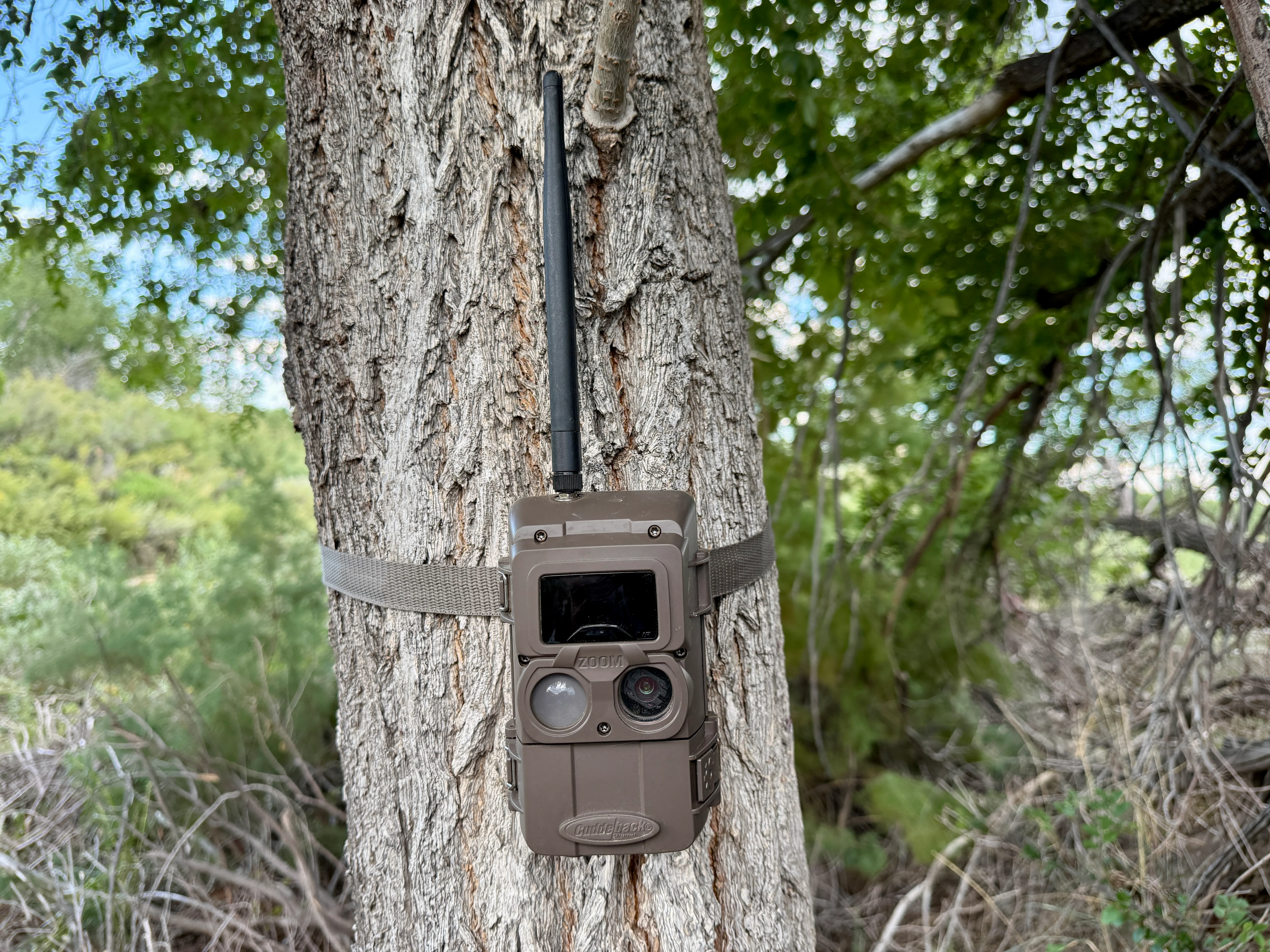
Cuddeback is keeping to its roots and staying on the CuddeLink train concerning its cellular cameras. The nice thing about Cuddelink is that using one Home camera and after purchasing one cellular plan, you can run as many as 24 cameras on one $10 cell plan. I opted for the $40 plan to receive unlimited photos. I went with the CuddeLink L-Series Cell Home ($130) and CuddeLink L-Seires cell cam ($150), so my initial investment was more. Still, I could add more CuddeLink-compatible cell cameras (up to 24) to my $40 per month plan.
Operationally, the Home (CuddeLink) and Remote (L-Series) systems are sound. However, you'll need to read heavy instruction manuals to get them linked to the same chain and go through the settings. It's not a problem, and it's not difficult. However, it will take you some time to learn the ins and outs of the system. This duo took much longer to learn about and get in the field.
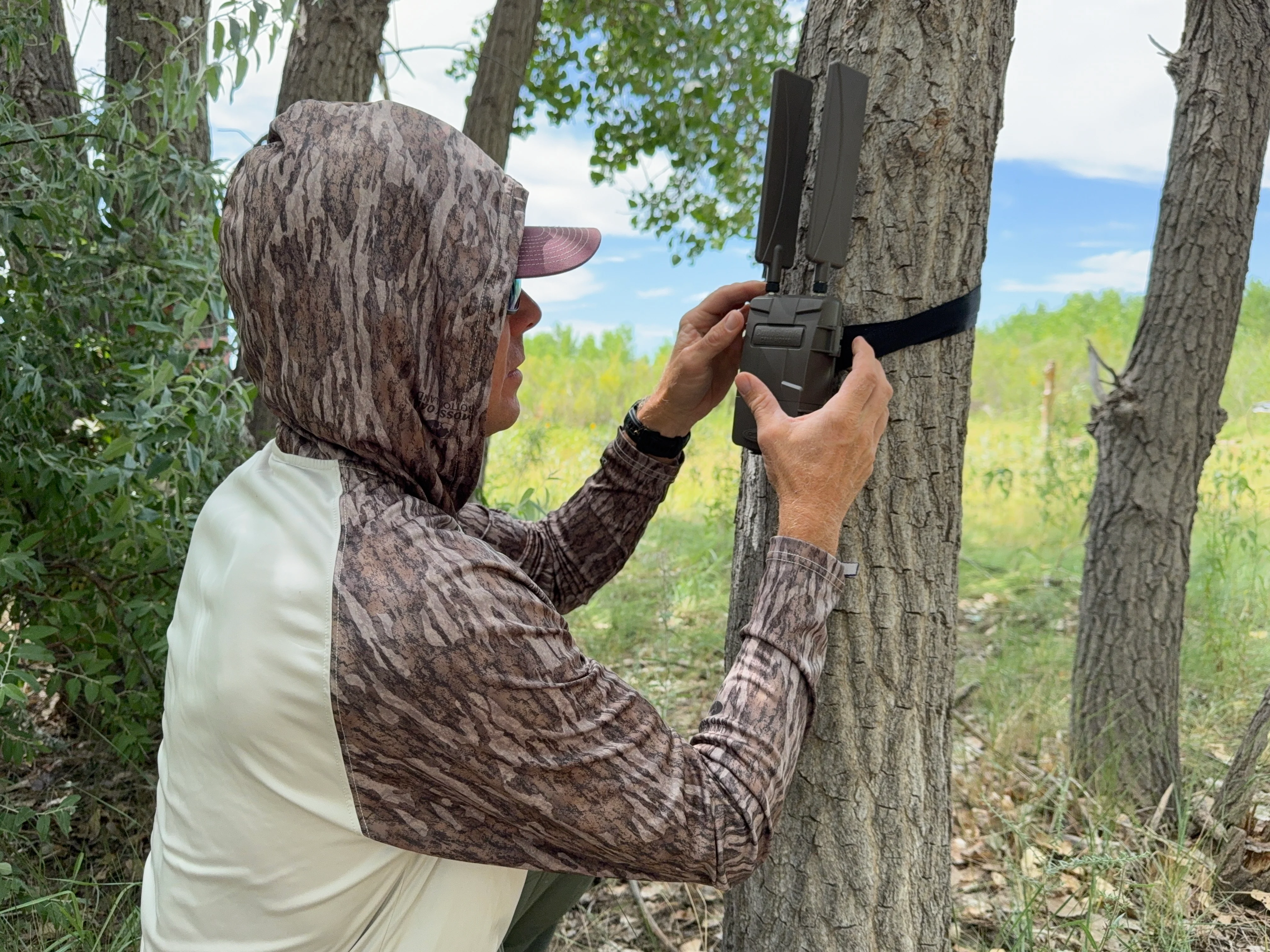
After setting the pair up, I could easily add more L-Series cell cameras and other Cuddelink cellular remote cameras and daisy chain them to the system. The initial setup, though, is a bit challenging and isn't as simple as downloading an app and turning the camera on.
The CuddeLink L-Series comes in multiple models. I tested the Zoom IR. The photo quality is decent, but what I do like about the camera is that it uses a center-angle Fresnel lens that increases detection range and zooms the photo in. It's important to note that I only ran the CuddeLink Home and CuddeLink L-Series Zoom IR for six days. The camera's arrival date was late. I plan to leave it out and will add more details soon. For now, it's taking pictures, centering images, and not spooking deer. I'm not in love with having the Home camera and then linking cameras to it, especially cellular, but the system does serve a purpose.
Reconyx Hyperfire 2
Specs
Trigger speed: 0.2 seconds
Detection range: 75 feet
Power: 12 AA batteries
Pros
Fastest trigger on the market
Outstanding picture and video quality
Five-year warranty is the best in the business
Cons
Very expensive
Requires a dozen batteries
Doesn’t send video
The Reconyx Hyperfire 2 is not new. In fact, it won our cell-cam test two year ago. Although Reconyx didn't have a new-for-2025 camera available for our test, I wanted to include here as a sort of benchmark. What you get with the Hyperfire 2 is raw performance. The image quality and lightning-fast trigger speed are as good as it gets. If you value that kind of performance above everything else, including price, this is the camera for you.

The price is main sticking point, however. It costs $600. Compared to the latest and greatest body designs, it’s also starting to feel a bit dated. The camera does not have a door, rather the entire case hinges open. The antennae are also on the flimsy side. There is a brace that comes with the camera to keep them together, but I lost it almost immediately after taking it into the field. The case itself is very robust, but there are better case designs out there now.

I found the Reconyx app to be a bit cumbersome to use, too, though it is packed with information about each photo. Images that aren’t requested for HD come in grainy and pixelated. But once you download an HD photo, it’s better than everybody else's. For me, the Hyperfire 2 is a camera for someone who really loves taking high-quality pictures of critters. And for that, I think it really does have a place with outdoors people, or even more serious users like biologists and wildlife photographers. As a hunting tool, this camera is for someone who wants to spot kickers, split G2s, and broken-off tines on specific bucks. It that's your game, you can't do better than this camera. On the other hand, if you’re not that kind of deer hunter, you're probably better off buying more, cheaper cameras to cover a larger area and scout more efficiently. —M.E.
Muddy Matrix
Specs
Trigger speed: .40 seconds
Detection range: 80 feet
Power: 8 AA batteries
Price: $100
Pros
Very good picture and video quality
Great app
Affordable plans
Good value
Cons
Comparatively slow trigger speed
Comparatively small detection range
Test-camera connectivity issues
Muddy does have an updated Matrix cell cam—the Matrix 2.0—for 2025, but we were not able to get one in time for our test. (We'll update this story when we do.) Meanwhile, we are including this review of the original Matrix, which is still available at some online retailers. The Matrix has plenty of checkmarks on the plus side of the ledger, but also a couple minuses to consider. Picture and video quality are very good. Also, the Muddy app (which is basically the same as Stealth Cam’s, if you’re familiar with that one) has some very nice features; you can “train” the camera to select for species, times of day, even individual animals. Also, the camera has dual AT&T and Verizon SIM cards, and automatically selects the strongest signal in the area.
I have to report, however, that I had a heckuva time getting my test camera to achieve a solid signal connection. On the one hand, I live in an area where this can be a problem, and it may not have been the camera’s fault. On the other, no other camera struggled so mightily. Also, trigger speed is comparatively slow.
That said, I do very much appreciate what Muddy is doing to make the cell-cam game more affordable to get into. One factor that makes folks hesitate to get into the wireless game is cost, leading to the legitimate question: Is is worth it? Muddy is doing it best to make that answer “yes” by offering deals for multiple cameras purchased at the same time, and some very affordable data plans. If you’re ready to dive into the wireless pool and need multiple units, this is a solid option and value. —Scott Bestul
Bushnell CelluCore No-Glow
Specs
Trigger speed: 0.2 seconds
Detection range: 80 feet
Power: 12 AA batteries
Price: $220
Pros
Good trigger speed
Solid daytime pics
Internal screen viewer to aid setup
Among the most simple setups in the test
Cons
Fairly spendy in comparison
Night pics suffer a bit at longer ranges
High-quality photos and easy setup are a huge plus with the CelluCore No-Glow. The impressive 0.2-second trigger speed helps capture sharp images and can keep up with fast-moving deer. Plus, the fast image recovery time recovery and subtle infrared flash elevate this cam to the next level. The only thing keeping this camera from the top models is a moderate detection range, and the data plans are, well, not much. It's not cheap either, though you may be able to find deals. —S.B.
Spartan GoCam Ghost
Specs
Trigger Speed: .4 seconds
Detection range: 60 feet
Power: 12AA batteries
Price: $430
Pros
First camera to offer live-streaming video
Great image/video quality
Rugged and durable housing and easy setup
Cons
Pretty average detection range and trigger speed
High price point
This is one of the best housing design around. In addition to being a cool-looking cam, the Spartan GoCam Ghost is rugged. It seems like it could get run over by a truck and keep snapping pics and shooting videos. The live-streaming option is decidedly cool for people who need MRI (most recent information) right now….though it may also raise eyebrows for those who question the ethics of trail cams in the first place. (I’m generally not one of them.) All of that said, the price is the main issue here. There are other really good cell cams for quite a bit less. —S.B.
How We Tested Cellular Trail Cameras
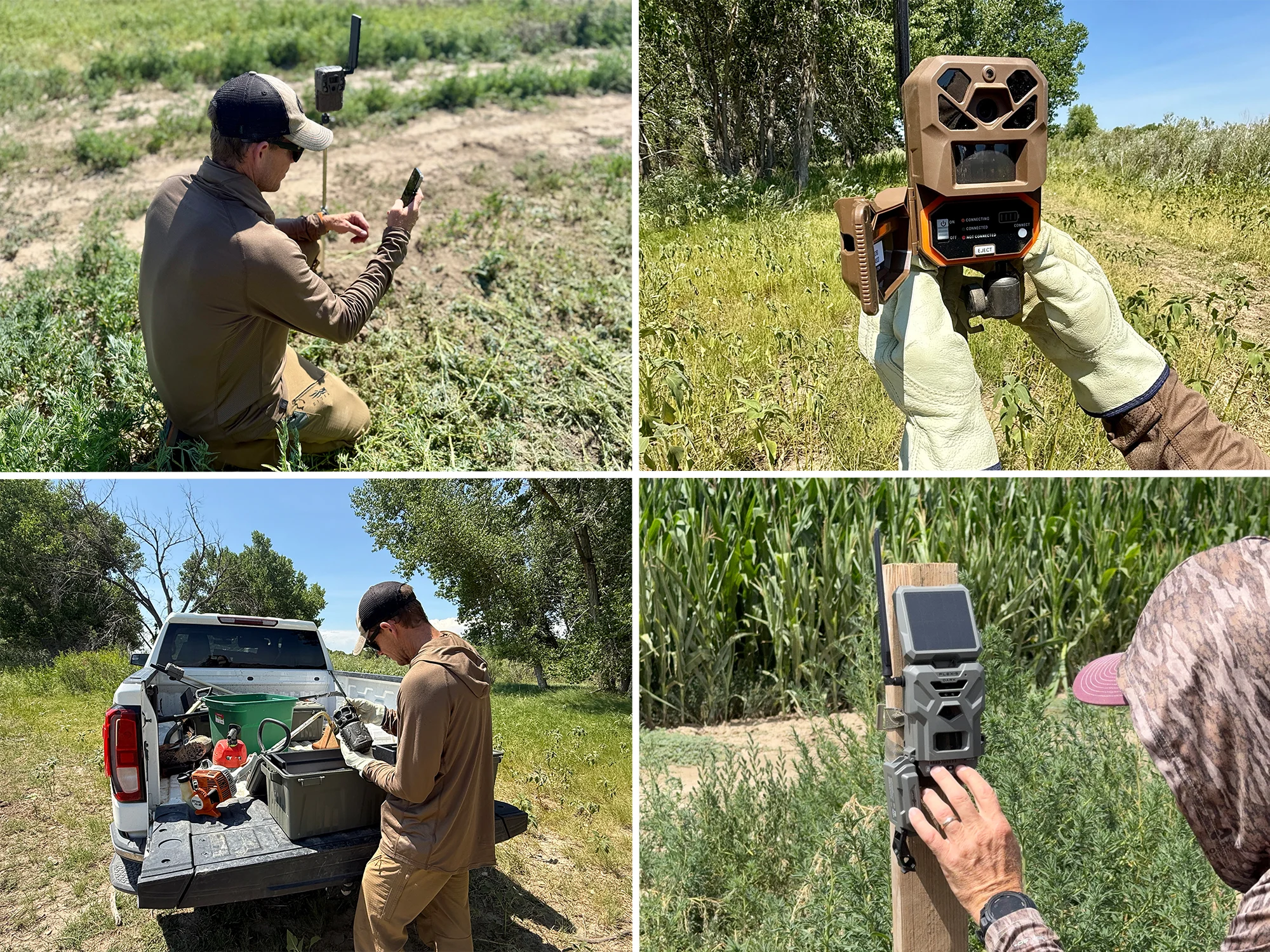
Thanks to some fantastic friends, I have access to over 700 acres of prime Colorado whitetail dirt. It proved to be the perfect testing ground for our 2025 cellular trail camera field test. Before heading to the field, I signed up for cell plans and downloaded apps to my smartphone. Then I set all of the cellular cams to take photos and 10-second video clips (if possible). I set all to take two pictures per trigger where available, and I adjusted the sensitivity setting that reduced the number of false triggers.
I tested all of the cams in my backyard first to ensure photos and vids were transmitting to the app before taking them afield. In the field, each cam monitored four different areas for five days. The areas included a pond, the edge of a corn field, a river crossing, and the inside corner of an alfalfa field. I examined hundreds of photos for clarity, color, the subject's position in the photo, and other features that each trail camera maker emphasized. I tested detection and flash ranges our to 141 feet, and I measure trigger speeds.
Throughout the test, I evaluated the cameras on construction, ease of setup, price, battery life, cellular performance, and camera performance. (For more on each of the test categories, see “What to Consider When Choosing a Cellular Trail Camera” below.) Finally, when all the testing and evaluating is done, we picked our winners and compiled the lineup.
What To Consider When Choosing a Cellular Trail Camera
Ease of Setup
Most cellular trail camera manufacturers have accepted the fact that not all their customers are 25 and were born with a smartphone in their hand, but some have not. Cellular cams should come with clear instructions and be easy to program and get running. All the cams I tested were run from an app where you set camera commands and settings, and where pics are sent. This is different than the original wireless cams, which typically sent images to the user via text (one of my buddies still refers to wireless cams as “texting cams” for this reason). How easily these apps set up, run, and monitor the camera is important.
Picture Quality
This can be tied into cost (as in, the more you spend, the better the pics), but not always. Trust me on this: After a while, the novelty of getting pics sent to your phone will wear off, and you’ll get irritated by blurred and grainy images. Some people are willing to give cell cams a pass on picture quality because they provide other benefits. I’m not one of them.
Trigger Speed
This is how long it takes the camera to snap a pic (or start shooting video) from when it detects movement. Generally speaking, the faster the better. One-fourth/second (0.25) is about as good as it gets, and a half-second is respectable for most camera setups. Anything much slower than that is decidedly ho-hum, and the camera better be darn good at something else.
Detection Range
This is the maximum distance at which a camera will “sense” a triggering object (hopefully a critter, but weeds and tree branches will also trigger it; something to keep in mind when setting cameras up). Again, as a rule, the greater the distance the better; the camera will get more pics of more animals.
App Quality and Bonus Features
A basic cell-cam app should make it easy for you to get the camera set up, change settings, and receive photos, but apps that make it especially easy to organize photos or identify trends to nail down daily patterns among the critters your monitoring can be a big plus. By the same token, little hardware extras, like mounts or brackets that help you aim the camera, are an important consideration, too.
Final Thoughts
This is the best batch of cell cams I've tested to date, and what really impresses me is that companies continue to add cool features, like live-streaming, without sending prices through the roof. The fact that most of these cameras are under $220, and some cost as little half that, is impressive.
Cellular trail cameras are game changers, and where legal, I will continue to take advantage of the right-now intel that they provide. The key things I look for in a cell cam is the ability to take video, good picture and video quality, and limited false triggers. As I said above, though, pretty much all of the camera I tested for 2025 passed those tests. In other words, you should be able to find the right camera for your needs above.
Why Trust Us
For more than 125 years, Field & Stream has been providing readers with honest and authentic coverage of outdoor gear. Our writers and editors eat, sleep, and breathe the outdoors, and that passion comes through in our product reviews. You can count on F&S to keep you up to date on the best new gear. And when we write about a product—whether it’s a bass lure or a backpack—we cover the good and the bad, so you know exactly what to expect before you decide to make a purchase.

